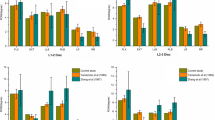Summary
In Dwyer's spinal column correction a titanium cable is stretched from vertebra to vertebra by a special clamp and secured to each vertebra with screws and clips. It is suggested to replace the titanium wire with wire consisting of the memory alloy NiTi. This will permit the prestretched wire to be tensioned by heating it to 60 deg C after it has been fixed at its ends in the vertebrae.
The functional principle of the NiTi memory wire was demonstrated in an experiment carried out on a plastic model. This consists of 8 plastic vertebrae with 30 mm sides which are connected by interposed wedge-shaped soft rubber discs, giving the model a curved shape. Memory wire prestretched by 7% is led through eylets on the convex side and fixed at the ends. On being heated (electrically in this experiment for the sake of simplicity), the wire shortens, righting the model so that it assumes a straight shape.
The authors also describe in detail the manufacture of the alloy, i.e. the melting and shaping operations, as well as the properties of the material, that is, the stress-strain and strain-temperature relationships and the transformation temperatures, as well as mechanical problems.
Zusammenfassung
Bei der Dwyerschen Wirbelsäulenkorrektur wird mittels einer Spezialspannzange ein Titankabel von Wirbelkörper zu Wirbelkörper verspannt und an jedem einzelnen mittels Schrauben in Agraffen festgeklemmt. Hier wird vorgeschlagen, das Titankabel durch einen Draht aus Memory-Legierung NiTi zu ersetzen. Dies ermöglicht das Spannen des vorgereckten Drahtes durch einfache Erwärmung auf etwa 60°C, nachdem dieser an den Enden in den Wirbelkörpern verankert wurde.
Die Wirkungsweise des NiTi-Drahtes wurde in einem prinzipiellen Versuch an einem Kunststoffmodell demonstriert. Das Modell besteht aus 8 Kunststoff wirbeln von 30 mm Kantenlänge, die durch dazwischengeklebte keilförmige Weichgummischeiben verbunden sind. Dadurch erhält das Modell eine gekrümmte Form. Der auf der konvexen Seite durch Ösen geführte und an den Enden verankerte Memory-Draht ist um 7% vorgereckt. Er wird in diesem Versuch der Einfachheit halber elektrisch aufgeheizt, verkürzt sich und richtet das Modell in eine gerade Form aus.
In diesem Zusammenhang werden auch ausführlich die Herstellung der Legierung, d. h. Erschmelzen und Umformen, die Eigenschaften, d. h. Spannungs-Dehnungs-Verhalten, Dehnungs-Temperatur-Verhalten und Umwandlungstemperaturen sowie mechanische Probleme beschrieben.
Similar content being viewed by others
Literatur
Baumgart, F., Jorde, J., Reiss, H.-G.: Memory-Legierungen —Eigenschaften, phänomenologische Theorie und Anwendungen. Techn. Mitt. Krupp, Forschungsberichte 34, H. 1 (1976)
Baumgart, F., Bensmann, G., Hartwig, J.: Mechanische Probleme bei der Nutzung des Memory-Effektes für Osteosyntheseplatten. Techn. Mitt. Krupp, Forschungsberichte 35, H. 3 (1977)
Buehler, W. J., Wang, E.: A Summary of Recent Research on the Nitinol Alloys and Their Application in Ocean Engineering. Ocean Engng. Vol. 1, pp. 105–120. London: Pergamon Press 1968
Dwyer, A. F., Schafer, M. F.: J. Bone Jt. Surg. 56B, 2 (1974)
Haasters, J., Schlegel, K. F., Baumgart, F., Bensmann, G.: Anwendungsmöglichkeiten von Memory-Legierungen zur Osteosynthese. I. experimentelle Studie. Orthop. Praxis 8/XIII, 531–535 (1977)
Henke, G.: Die operative Skoliosenkorrektur nach Dwyer. Orthop. Praxis 10/XI, 747–751 (1975)
Rathke, F. W., Schlegel, K. F.: Orthopädisch chirurgischer Operationsatlas (Hrsg.: M. Hackenbroch u. A. N. Witt), Band III: Wirbelsäule und Becken. Stuttgart: G. Thieme 1974
Schlegel, K. F.: Memory-Legierungen — ein neues ImplantatMaterial für die orthopädische Chirurgie. Orthop. Praxis 8/XIII, 528–530 (1977)
Schlegel, K. F.: Therapie der Skoliose heute. Orthop. Praxis 8/XI, 561–562 (1975)
Zielke, K., Stunkat, R., Duquesne, J., Beanjean, F.: Ventrale Derotationsspondylose. Orthop. Praxis 8/XI, 562–569 (1975)
Author information
Authors and Affiliations
Rights and permissions
About this article
Cite this article
Baumgart, F., Bensmann, G., Haasters, J. et al. Zur dwyerschen skoliosenoperation mittels drähten aus memory-legierungen. Arch. Orth. Traum. Surg. 91, 67–75 (1978). https://doi.org/10.1007/BF00383644
Issue Date:
DOI: https://doi.org/10.1007/BF00383644




